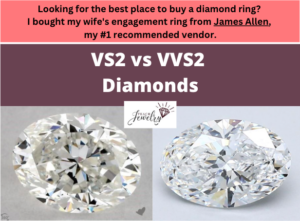
Two categories on the GIA clarity scale are VS (very slightly included), and VVS (very, very slightly included), which are broken down in VS2, VS1, VVS1, and VVS2.
The main difference between VS2 and VVS2 diamonds are the number of inclusions and the extent to which they impact the gem. A VVS2 diamond has smaller inclusions barely visible with 10x magnification. The flaws in VS2 diamonds are sometimes noticeable without magnification.
We’ll compare VS2 versus VVS2 diamonds, including an overview of each, their differences, and how to decide which one to choose.
What are VS2 Clarity Diamonds?
VS2 clarity diamonds have inclusions that are easily visible with magnification but often invisible to the naked eye.
The grade isn’t referring to an exact number of blemishes, their size, or type.
Instead, gemologists assign that grade based on the overall effect of those inclusions. But that judgment takes into account those traits.
As an example, here’s a one-carat VS2 clarity diamond from renowned online jeweler James Allen.
It features six types of inclusions:
- Crystals
- Cavity
- Needles
- Clouds
- Indented natural
- Natural
The GIA report below shows the flaws are minor and scattered across its table and pavilion.
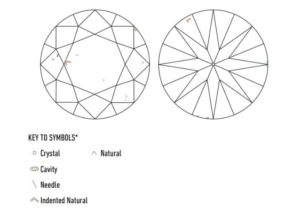
As a contrast, this VS2 diamond only has three types of inclusions: a crystal, indented natural, and natural.
Ultimately, clarity is a subjective assessment. So it’s important to have it examined by a reliable organization.
What are VVS2 Diamonds?
VVS2 diamonds have minuscule inclusions that are difficult to identify, even with 10x magnification.
In fact, the gemologist may have to scan the diamond a few times to find a transparent twinning wisp, a white feather, or pinpoints.
On the clarity scale, VVS2 is positioned one grade below VVS1 and one above VS1.
I’ve highlighted that position on the scale below, in addition to where it’s located relative to VS2.
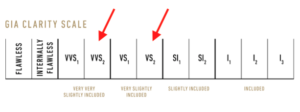
It’s almost impossible for the naked eye to tell the difference between clarity grades that are beside each other on the scale, but if you lined up all three next to each other, you may notice the difference between the VS1 and VVS1 diamonds.
Similar to VS2 diamonds, the grade isn’t an indication of a particular number or type of inclusion. It could have several flaws of the same kind or a singular instance of three or four.
This princess-cut VVS2 diamond has five types of inclusions.
The report lists:
- Cloud
- Needle
- Pinpoint
- Feather
- Natural
Other diamonds can receive the same clarity grade with only two inclusions.
No matter which are present in a VVS2 diamond, they’re small and in positions that minimize its impact. For example, it’s inclusions may be located on the pavilion instead of the table.
What are the Differences Between VS2 and VVS2 Diamonds?
1. Inclusions in VS2 Diamonds are More Impactful
In most cases, a VS2 diamond has more inclusions than one graded VVS2. It’s not unusual for a VS2 clarity gem to have more than five unique types, plus the inclusions you should avoid.
You might find a combination of etch channels, indented naturals, black spots, and twinning wisps all in the same diamond. They’re often small, but many buyers want to avoid a gem with that many imperfections.
This is especially true for engagement ring diamonds. Many consider VS1 or higher for the center gem but are less concerned about the clarity grade of smaller accents or diamonds on other types of jewelry.
They’re often so small that SI2 or I1 diamonds are used as a cheaper alternative.
For example, the side stones on this princess cut diamond ring earned SI2 grades, but they’ll appear eye-clean because they’re so small.
There are plenty of VVS2 diamonds available that have only two or three inclusions.
You can find one featuring insignificant flaws like pinpoints and needles, which won’t affect its performance in any way.
2. VVS2 Diamonds Display More Fire and Brilliance
VVS2 diamonds can display more fire and brilliance than ones graded VS2 because inclusions have the potential to distort the way light reflects off its facets.
The quality of a diamond’s cut is the most important factor in light performance, but you shouldn’t ignore the effects of dark inclusions.
In diamonds with excellent or very good cuts and a lack of inclusions, light can cleanly hit the facets, bounce around inside the diamond, and return to the viewer.
Little is leaked through the culet or released at a poor angle.
But when inclusions are present, this process isn’t as clean.
The inclusions in a VVS2 diamond are rarely significant enough to make a noticeable impact.
This engagement ring features a VVS2 diamond that has an ideal cut, and it would shine in the same way as a flawless one.
You can expect diminished brilliance in a VS2 diamond, but it’s likely not noticeable to the naked eye.
I recommend choosing an excellent cut with that same grade for its symmetry and polish. These factors compensate for some distortion caused by the inclusions.
If you only have the budget to choose a higher clarity grade, such as VVS2, or an excellent cut, go with that cut and a lower clarity grade that results in an eye-clean diamond.
3. VVS2 Diamonds Sell for a Premium
Buyers are willing to pay a higher price for fewer inclusions because of the negative effects they have on its quality. As you move up the clarity scale from I3 and SI2 to internally flawless (IF) and flawless (FL), you’ll pay a premium.
In general, expect to pay 10-15 percent more for each step up the scale.
But the best way to compare prices for VVS2 versus VS2 diamonds is to assess the costs for diamonds that are equal in every other way.
I examined prices for round-cut VVS2 and VS2 diamonds from James Allen that had the following grades:
- Carat weight: 0.90
- Color: F
- Cut: Ideal
The average price for a diamond with those qualities and a VS2 clarity grade was $6,863. The range was $5,850-$7,830.
For VVS2 diamonds, the average was $8,367, with a range of $6,820-$9,450.
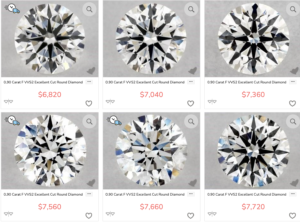
That’s a 22 percent premium for VVS2 diamonds over VS2.
But as you can see, there are plenty of exceptions to these prices.
Some VVS2 diamonds are less expensive than ones graded VS2, but in general, you’ll pay more for fewer inclusions.
If you choose a VS2 diamond for its lower cost, you can put that savings toward a setting or higher grades across color, carat weight, or cut.
That’s exactly what I did.
I chose a VS1 clarity diamond for my wife’s engagement ring because of the cost savings compared to higher grades. I was able to choose an excellent cut and high color grade, so it looks flawless and colorless.
4. VS2 Diamonds Aren’t Always Eye-Clean
I also recommend prioritizing eye-cleanliness over a specific clarity grade, whether you choose a VS2 or VVS2 diamond.
For most diamonds under two carats, a VS2 clarity indicates inclusions aren’t visible without magnification. There could be several types of inclusions on its table and pavilion, but you’d need magnification to identify them.
Here’s an example of a VS2 diamond in high-resolution.
Even when you rotate the image, blemishes are difficult to spot.
As you approach 2.5 carats, you may need to select a higher clarity grade, like VS1 or VVS2.
In almost every case, a VS1 or higher clarity grade is a sign of eye-cleanliness.
But I always recommend viewing the diamond in-person or through high-resolution images before buying it. You might notice black spots across its table or a bruise that’s a dealbreaker.
Traits like these aren’t always apparent in the grading report, so it’s important to not solely rely on the report.
Through a combination of its clarity grade, a grading report from a reliable organization, and quality photos, you can have confidence buying your VS2 or VVS2 diamond without setting foot in a retail store.
That’s the journey I took for my own diamond purchase. When it arrived at my house, it was exactly as I expected because I’d done the detailed research online.
How to Decide Between VS2 and VVS2 Diamonds
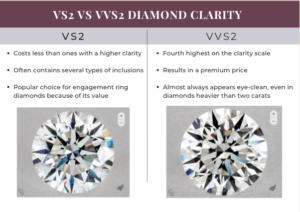
Deciding between VS2 and VVS2 diamonds involves understanding how inclusions impact its appeal and performance.
Here are some tips to help you choose.
Opt for a VS2 diamond if:
- You want a diamond less than two carats that likely appears flawless but costs less
- It isn’t a concern to you if the diamond has several types of inclusions
- Those savings would allow you to choose higher grades for other aspects of the diamond
Consider a VVS2 diamond if:
- You want a diamond where inclusions are barely visible, even with magnification
- The diamond weighs more than two carats
- You’re willing to pay a premium for a lack of imperfections
By exploring diamonds assigned each clarity grade, you’ll find the right one for your ring.

Jacob Clarke
Jacob Clarke is the founder of TeachJewelry.com.
He earned an Applied Jewelry Professional Diploma from the Gemological Institute of America (GIA) and now brings you essential information about diamonds, settings, and more.
Jacob has consulted with leading jewelry brands, and his work has been cited in Clean Origin, Diamond Nexus and industry publications.
He's also a member of the International Gem Society.
He enjoys discussing jewelry with readers, so contact him with any questions at jacob.clarke@teachjewelry.com.

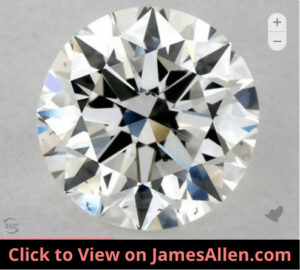
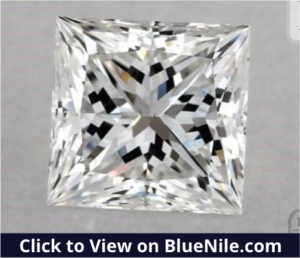
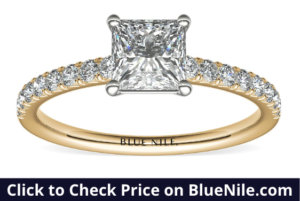
![VVS2 Diamond Engagement Ring]](https://teachjewelry.com/wp-content/uploads/2022/03/VVS2-Diamond-Engagement-Ring-James-Allen-1-300x213.png)
![Eye-Clean VS2 Diamond]](https://teachjewelry.com/wp-content/uploads/2022/03/Eye-Clean-VS2-Diamond-Blue-Nile-300x255.png)












